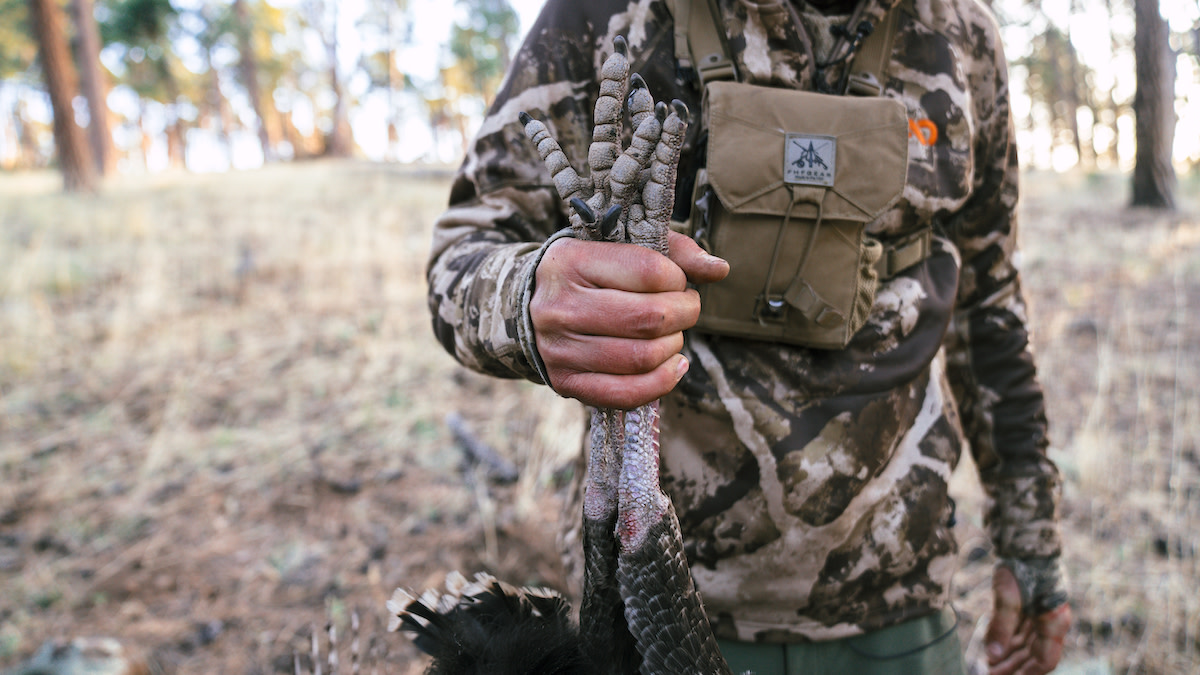
When I started turkey hunting, it was run-and-gun or nothing. We didn’t have hub-style blinds, and we didn’t even consider sitting in one spot for hours upon hours. The goal was to slip into a gobbler’s orbit, work him in, and that was it.
If he screwed up, we’d kill him. If he didn’t, it was time to move. Lather, rinse, and repeat.
That strategy still works and is a viable move if you have the land to roam and the itch to roam it. But there’s a counterargument worth considering, where a less-is-more attitude can work in a turkey hunter’s favor. It’s a patience-first approach, that is backed up by turkey research.
Turkey Research
Wildlife research can provide amazing insights into game behavior, but most of the heavy lifting in this arena centers on ungulates and apex predators. The lowly wild turkey has been largely ignored as a topic of research, but not by Dr. Michael Chamberlain, a previous guest on the MeatEater Podcast.
Chamberlain, a professor and wild turkey researcher with UGA, is a wealth of knowledge on turkey predation, behavior, and how they view the hours in their day. According to Chamberlain, some of his research shows that hunters are just too quick to give up on gobblers when they should probably dig in and wait.
“We routinely see that toms will visit places where hunters called to them, hours after the hunters have left the field,” Chamberlain said. “To me, that speaks to the idea we would find more success as hunters if we were willing to be more patient.”
How to Play the Waiting Game
The easiest way to be patient in the turkey woods is to not have any real options to roam. This happens during small-property hunts, as well as some turkey bowhunts where the necessary gear is an impediment to mobility. If you aren’t resigned to 20 acres or obsessed with the satisfying thump of an arrow hitting a longbeard, then patience comes down to discipline.
Let’s say you had a gobbler respond an hour after sunrise, and during that time he was hot and heavy. But he wandered off, as they often do, and it has been an hour since you heard him gobble. The devil on your shoulder whispers that it is either time to go find him or call it quits.
After all, what are the odds the bird will come back? Who knows? I don’t. Neither does a turkey researcher like Chamberlain, but the smart money is on patience. Figure out a way to sit for another half hour, or an hour, at the very least. Maybe you can’t pull an all-day sit with your back to a tree and your shotgun across your lap, but adding some extra time to each setup can put you on more birds that weren’t into committing initially.
This is a hard thing to do without confidence, though.
Turkey Patience Lessons
When I first started bowhunting turkeys like a fiend, I had to rethink my shotgun strategy. Instead of going to the birds, or at least trying to slip in close enough to talk them in, I had to find a good spot and trust my calling and decoys.
The first all-day sits were brutal, absolutely brutal. They were also enlightening. I watched birds with hens early in the morning that often suddenly showed up, solo, hours later. Frequently, it would be a specific bird, or a group of birds, that was identifiable enough to say with confidence they weren’t just new randos.
Experiencing that a few times does wonders for your confidence. You realize that the birds that feel like they’ve walked out of your life for good, often haven’t. They’ve just got better prospects at the moment, but also a good enough memory to know right where you—their Plan B—is. Or at least, was.
Now, if you’ve got other birds hammering away and the ability to get closer, waiting around might not be the best idea. But if you don’t have that, and you did have some positive interactions earlier in the day, giving it some real time is a great way to reconnect with those not-so-long-long toms.
Conclusion
It seems simple, like doing all-day rut sits for whitetails. Scratch that; it is simple, but simple isn’t always easy. Tacking on an extra hour to each run-and-gun setup, or grinding out a dark-to-dark bowhunt in May, isn’t easy. But it can be necessary to fill your turkey tag, especially if you’re hunting pressured birds that aren’t suicidal. Just remember that they’re not working off of your time or your schedule.
They are working off of theirs, and they are usually in no hurry.






Conversation